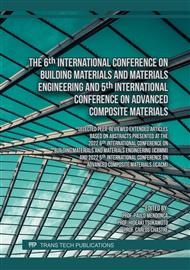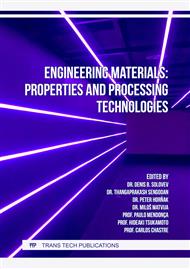[1]
Mikula, K., Skrzypczak, D., Izydorczyk, G., Warchoł, J., Moustakas, K., Chojnacka, K., & Witek-Krowiak, A. 3D printing filament as a second life of waste plastics—a review. Environmental Science and Pollution Research, 2021, 28(10), 12321–12333
DOI: 10.1007/s11356-020-10657-8
Google Scholar
[2]
Lafhaj, Z.; Dakhli, Z. Performance Indicators of Printed Construction Materials: a Durability-Based Approach. Buildings, 2019, 9, 97. https://doi.org/10.3390/buildings 9040097.
DOI: 10.3390/buildings9040097
Google Scholar
[3]
Sotorrío Ortega, G.; Alonso Madrid, J.; Olsson, N.O.E.; Tenorio Ríos, J.A. The Application of 3D-Printing Techniques in the Manufacturing of Cement-Based Construction Products and Experiences Based on the Assessment of Such Products. Buildings, 2020, 10, 144.
DOI: 10.3390/buildings10090144
Google Scholar
[4]
Ruscitti, A.; Tapia, C; Rendtorff, N.M. A review on additive manufacturing of ceramic materials based on extrusion processes of clay pastes. Cerâmica, 2020, 66(380).
DOI: 10.1590/0366-69132020663802918
Google Scholar
[5]
Katzer, J.; Szatkiewicz, T. Effect of 3D printed spatial reinforcement on flexural characteristics of conventional mortar. Materials, 2020, 13, 3133.
DOI: 10.3390/ma13143133
Google Scholar
[6]
Zaneldin, E.; Ahmed, W.; Mansour, A.; Hassan, A.E. Dimensional Stability of 3D Printed Objects Made from Plastic Waste Using FDM: Potential Construction Applications. Buildings, 2021, 11, 516.
DOI: 10.3390/buildings11110516
Google Scholar
[7]
Abdallah, Y.K.; Estévez, A.T. 3D-Printed Biodigital Clay Bricks. Biomimetics, 2021, 6, 59.
DOI: 10.3390/biomimetics6040059
Google Scholar
[8]
Kristiawan, R. B.; Imaduddin, F.; Ariawan, D.; Arifin, U. A review on the fused deposition modeling (FDM) 3D printing: Filament processing, materials, and printing parameters" Open Engineering, 11(1), 2021, 639-649
DOI: 10.1515/eng-2021-0063
Google Scholar
[9]
Turhan, D.; Celep, Z.; Zain-Edden, I.K. Transient wave propagation in layered media conducting heat. Journal of Sound and Vibration, 1991, 144, 247–261. https://doi.org/10.1016/ 0022-460X(91)90747-8.
DOI: 10.1016/0022-460x(91)90747-8
Google Scholar
[10]
Ahmed, W.; Ahmed, S.; Alnajjar, F.; and Zaneldin, E. Mechanical performance of three-dimensional printed sandwich composite with a high-flexible core. Proceedings of the Institution of Mechanical Engineers, Part L: Journal of Materials: Design and Applications, 2020, 235(6).
DOI: 10.1177/14644207211011729
Google Scholar
[11]
Oussai, A., Bártfai, Z., & Kátai, L. Development of 3d printing raw materials from plastic waste. a case study on recycled polyethylene terephthalate. Applied Sciences, 2021, 11(16), 7338–7338.
DOI: 10.3390/app11167338
Google Scholar
[12]
Pinho, A. C., Amaro, A. M., & Piedade, A. P. 3d printing goes greener: study of the properties of post-consumer recycled polymers for the manufacturing of engineering components. Waste Management (New York, N.y.), 2020, 118, 426–434.
DOI: 10.1016/j.wasman.2020.09.003
Google Scholar
[13]
Ahmed, W.; Alnajjar, F.; Zaneldin, E.; Al-Marzouqi, A.H.; Gochoo, M.; Khalid, S. Implementing FDM 3D printing strategies using natural fibers to produce biomass composite. Materials, 2020, 13(18), 4065. doi.org/.
DOI: 10.3390/ma13184065
Google Scholar
[14]
Ciampi, G.; Spanodimitriou, Y.; Scorpio, M.; Rosato, A.; Sibilio, S. Energy performances assessment of extruded and 3D printed polymers integrated into building envelopes for a South Italian case study. Buildings, 2021, 11, 141.
DOI: 10.3390/buildings11040141
Google Scholar
[15]
Goh, G.D.; Yap, Y.L.; Tan, H.K.J.; Sing, S.L.; Goh, G.L.; Yeong, W.Y. Process-structure- properties in polymer additive manufacturing via material extrusion: A review. Critical Reviews in Solid State and Materials Science, 2020, 45, 113–133.
DOI: 10.1080/10408436.2018.1549977
Google Scholar
[16]
Udroiu, R.; Braga, I.C. System performance and process capability in additive manufacturing: Quality control for polymer jetting. Polymers, 2020, 12, 1292. https://doi.org/10.3390/ polym12061292.
DOI: 10.3390/polym12061292
Google Scholar
[17]
Siraj, I., Bharti, P.S. Process capability analysis of a 3D printing process. Journal of Interdisciplinary Mathematics, 2020, 23, 175-189.
DOI: 10.1080/09720502.2020.1721711
Google Scholar
[18]
Modi, Y.K.; Sahu, K.K. Process capability analysis of binder jetting 3D printing process for fabrication of calcium sulphate based porous bone scaffolds. Australian Journal of Mechanical Engineering, 2020, 1-9.
DOI: 10.1080/14484846.2020.1842295
Google Scholar



